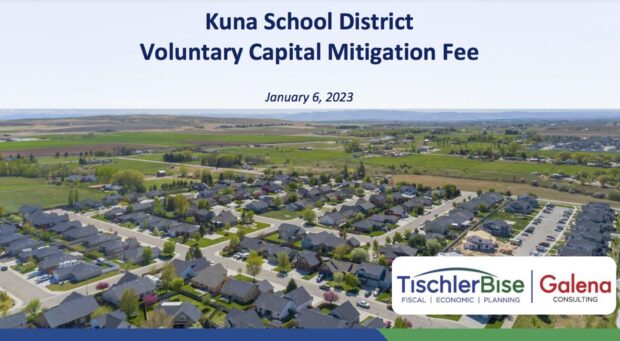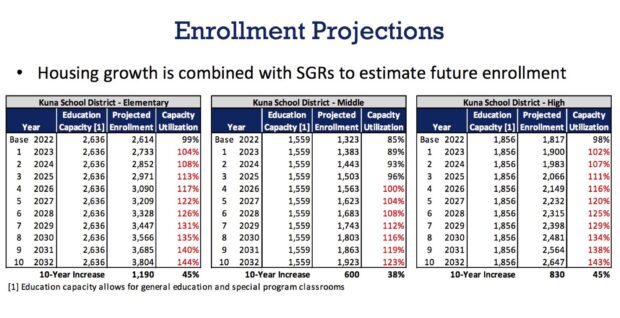
The Kuna School District’s efforts to convince commercial developers to help pay for new schools is gaining momentum.
The district is asking new development projects to voluntarily pay a school impact fee to help fund schools in areas where housing is being developed. Fire departments and police collect fees through the building permit process to support new infrastructure. School impact fees are not allowed for school facilities within Idaho code.
But builders can pay the fee for school voluntarily.
Some developers have agreed to donate over $1 million worth of land to the district for future schools. Others are rejecting the idea of a voluntary contribution that increases builders’ one-time impact fees on residential housing by 35%.
Many of Kuna’s schools are nearly full, and with an estimated increase of 4,000 more students over the next 10 years, school officials anticipate having 2,700 kids who won’t have classrooms or teachers.
Still, voters rejected their $111.4 million bond issue in March for several projects, including a new elementary school, a classroom wing and athletic facilities at Swan Falls High School, and renovations at Fremont and Kuna middle schools.
But the district says the demand for additional schools is not going away, so Kuna formalized its message to developers to help build classroom capacity, proposing a fixed cost for each new housing unit or multifamily unit.
The following graph reflects the number of new homes and multifamily buildings constructed in the previous five years.

The growth committee helps developers see the impact of residential development
Called the growth team, leaders Danielle Horras and Robbie Reno engage developers on how they can voluntarily contribute funds for new school facilities, and they advocate for the district’s needs with city and county planning officials.
“We talk about the goals of our community,” said Horras, the district’s director of strategic partnerships. “Engaging developers means letting them know … the impact on the school district.”
Those conversations are increasingly about neighborhood schools being full and the need to bus students.
“(Parents) prefer to have their child play, learn and go to school all in the same neighborhood. It’s part of the appeal of buying a home,” said Horras.
According to TischlerBiseGalena Consulting, in five years Kuna’s 11 schools will be 1,000 students overcapacity; in ten years, that gap grows to nearly 2,700 kids.
Their report projects an average student growth rate of around 5% annually.
“Large families move to this community. And they do so with the desire to have public school systems that can support their children,” Horras said.
Should developers absorb some of the costs for new schools?
Four developers have already agreed to contribute when their properties start to develop out. And in the last year, two more developers offered land to build a new school facility.
Taylor Merrill Westpark Companies offered 10 acres of land in Patagonia East valued at $1 million. The company originally planned to donate half the acreage but the board’s new strategic outreach swayed them to donate 100% of the land. There is flexibility in how the voluntary contribution is met, like land or equipment. Another land donation proposal is still under consideration.
Rather than having “to spend bond money on buying land, we can put that public money to better use for schools and facilities,” said Reno, associate district planner and principal of Swan Falls High School. “If we don’t have school sites, we can’t build.”
Not all developers agree. Some likely oppose more impact fees, because Ada County currently collects $3,493, the City of Kuna $2,875, and the Kuna Rural Fire District $1,792, according to the report. Additional fees reduce profit margins.
The schools are asking for $3,270 per home, which is 10% of the $32,700 impact a house has on the school district, according to the report.
“Some developers don’t think that it’s their responsibility,” Horras added.
At a recent planning and zoning meeting, Horras testified that the school district was full and could not serve the students who would be generated from a new apartment complex being proposed.
“And when the question was posed in the room, what do we do with these students? How do we serve them? The developer said ‘homeschool’ out loud in the meeting,” Horras said.
“That makes me feel bad for the families who are moving into the apartment with the belief that there is a system set up to support their children to learn. It is a good example of what happens when we don’t have great collaboration,” she said.
To be more effective as a collaborative partner, the district hired a national firm to analyze the impact of development and determine an adequate fee structure for potential builders who chose to participate.
“So that’s how we start our conversations with developers: For you to bring your development into our community, this is the specific impact on the school district,” Horras said.
However, in the face of an additional three thousand dollar fee, some developers question what a fair amount should be. District spokesperson Allison Westfall said, “We commissioned the analysis and report …, which confirmed our growth projections and the methodology for determining a contribution amount.”
The report projects several hundred new homes in Kuna each year
The school fee of $3,270 per home is calculated to cover a proportionate share of the capital cost for a new school, according to the report. TischlerBiseGalena’s report is available at this link.
Based on the firm’s formula, each single family unit is estimated to generate a total of 0.513 students, with 0.236 in elementary grades, 0.120 in middle school grades, and 0.157 in high school grades. A multifamily unit is estimated to generate 0.435 students per unit.
On average, there have been 459 single family units and six multifamily units constructed each year. Additionally, there are 8,000 platted but unbuilt lots in the district, according to the report.
“Based on the trends in Kuna, available platted lots, and available land in unincorporated areas of the school district, TischlerBiseGalena conservatively projects an annual growth of 515 homes in the school district. This would total 5,150 new housing units over the next ten years,” the report states.
The impact of new families entering the Kuna School District is quantified in the graph below.

The growth team noted two recent trends: there is more high-density construction and there are more national builders entering the marketplace.
“We want to make sure that when families move into their homes, that things go smoothly, and we think that that’s really a shared goal between the school district and developers,” Horras said.
“It’s really about being collaborative and solving this gap of capacity, so that every student in Kuna has a place to learn every day.”
